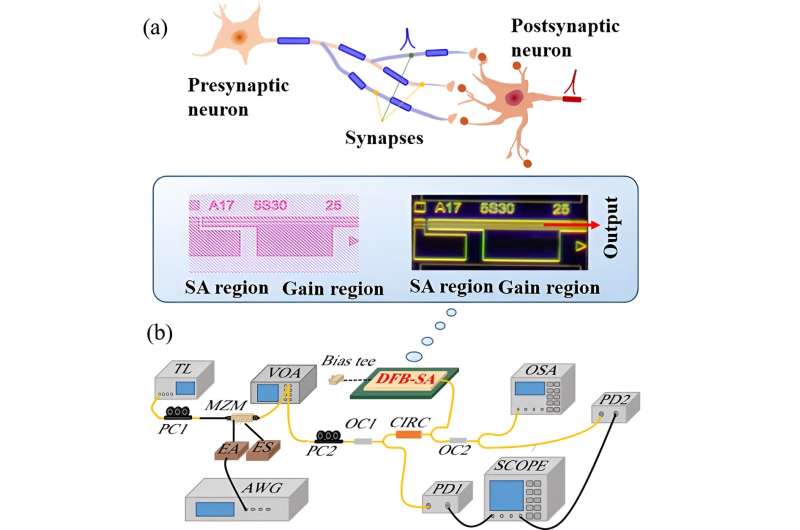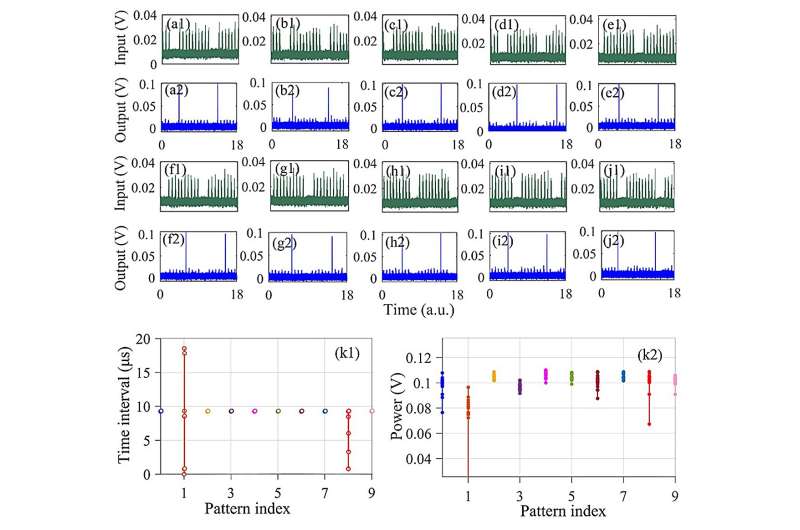This article has been reviewed according to Science X's editorial process and policies. Editors have highlighted the following attributes while ensuring the content's credibility:
fact-checked
proofread
Multi-synaptic photonic spiking neural networks based on a DFB-SA chip

Compared with traditional artificial neural networks, spiking neural networks (SNN) are more biologically authentic, more powerful, and less power-consuming due to their spatiotemporal coding and event-driven characteristics. In recent years, optical computing has been widely considered as a hardware acceleration platform, where nonlinear computing poses a challenge. Photonic SNN provides an ultra-fast and energy-efficient platform for high-performance neuromorphic computing.
Due to the potential of compact size and high reliability, integrated architecture provides a reliable optical neuromorphic computing architecture scheme. Two-section semiconductor lasers could be adopted as photonic spiking neurons, capable of mimicking neuron-like responses and performing nonlinear calculations like neurons.
However, the strong nonlinearity of SNN and the training difficulties caused by hardware constraints put forward an urgent need for efficient SNN algorithms. At the same time, the collaborative computing of algorithms and hardware platforms has become a new challenge.
To address the nonlinear computational challenges of optical neural networks, a research group independently developed a distributed feedback semiconductor laser chip containing a saturable absorption region (DFB-SA) as an optical spiking neuron, which can successfully simulate neuron-like dynamics, such as excitable response, threshold and integration behavior. The research is published in the journal Opto-Electronic Science.
Inspired by the multi-synaptic structure and delay-weight plasticity in biology, a multi-synaptic SNN structure and delay-weight cooperative supervised learning algorithm were proposed to train the optical SNNs and realized the hardware-software collaboration between the pattern classification algorithms based on the optical SNN and the DFB-SA laser chip.

Compared with the existing common algorithms, the learning efficiency and performance of this algorithm were excellent, and the introduced multi-synaptic connection could effectively improve the network performance with different learning algorithms. In order to realize the collaborative computing of algorithm and hardware, time division multiplexing technology was used to encode the input received by different output neurons in different time intervals, and the classification mode was verified experimentally based on a single DFB-SA laser chip. Different types of input could only stimulate the corresponding output neurons to produce a single spike.
Moreover, in repeated tests, although the output spike power fluctuated greatly, the spiking timing was relatively stable, demonstrating the robustness of time coding. This study realizes functional photonic SNN far beyond the limit of hardware integration scale and demonstrates the capability of hardware-algorithm collaborative computing. This work is an important step in promoting the practical application of integrated photonic SNN chips and lays an important foundation for the hardware realization of large-scale optical SNNs.
The DFB-SA laser chip reported in the paper, based on the traditional InP-based generic foundry platform, has the features of integration, low power consumption, high speed, and easy tuning, which is suitable for application scenarios of large bandwidth, high speed and low latency. It lays down the device foundation for the realization of an integrated optical neuromorphic computing system, which is expected to play a role in applications such as data centers, edge computing, and automatic driving.
More information: Yanan Han et al, Pattern recognition in multi-synaptic photonic spiking neural networks based on a DFB-SA chip, Opto-Electronic Science (2023). DOI: 10.29026/oes.2023.230021


















